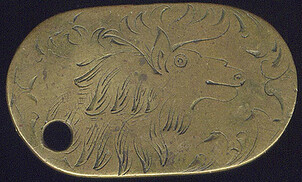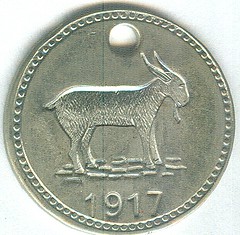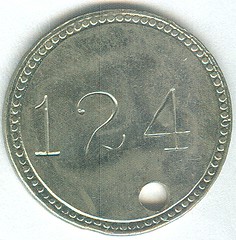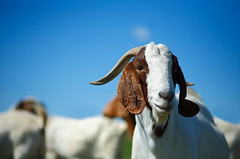
PREV ARTICLE
NEXT ARTICLE
FULL ISSUE
PREV FULL ISSUE
MORE ON GOAT TAGS AND CHARLES GRISHKATEric von Klinger writes:
The site is an odd bare-bones web page with a contact form. But livestock tags make perfect sense - I'd just never seen one before. And I'm still curious about this one. It looks like a one-of-a-kind handmade item.
-Editor

Tom Casper writes: In your Sept. 2, 2012 E-Sylum article on goat tags, you asked if anyone had seen another. I have attached scans of a piece in my collection. Unfortunately, it is an unattributed maverick. The obverse pictures a goat and the date 1917. The reverse is stamped with the number 124. The piece is nickel, 25mm and holed as made. A second identical piece I have has a different number on the reverse. I would appreciate hearing from anyone if they know where these were used.


Kay Olson Freeman dug up some info on Charles J. Grishkat. She sends these notes: Charles J. Grishkat
Born: 1881, Eurbourg, Lithuania
1912 – 1918 manager of saloon, 91 Court St., Middletown, CT. He is not married then. Grishkat will always be associated with saloon; but only those years at 91 Court St. Later address will be 97 Court St – possibly town re-numbered streets? Charles Grishkat marries in 1920’s to Anna [Arasimowicz?] (b. 1903, New Briton, CT – dies 2005, Middletown, CT). The question remains as to the meaning of “goat tag.” I do not see any heraldic significance of goat in Lithuanian town arms. Charles Grishkat may have been Capricorn astrological sign as one time he says he was born December. Gene Brandenburg writes: A saloon token ? This gets better & better.
Mike Packard found an obituary of Charles Grishkat's wife Anna, who remarried after his death. One of her granddaughters lived in Alexandria, VA:
Anna Balascak
(www.legacy.com/obituaries/hartfordcourant/obituary.aspx? Tom Kays writes: In response to an enquiry from Gene Brandenburg regarding the origin and meaning of a “goat tag,” with “Charles Grishkat, 97 Court Street, Middleton Conn”, we note the awesome power of the E-Sylum readership. Kay Olson Freeman responded with a biographical sketch of Charles J. Grishkat, born in Lithuania in 1881. He managed a saloon at 91 Court Street from 1912 – 1918. Mike Packard provided further information that Mr. Grishkat’s close relations survived to 2005. Further speculation of the brass artifact found no heraldic significance to goat heads in Lithuanian town coats of arms. Whether Charles Grishkat was a Capricorn (December birth) remains unclear. Now I have dog tags from persons and canines and brass cow tags from, not cows, but farmers who tag the poor cow’s ears, and this goat tag is of an intermediate size between canine and cow tag. Depicted is a critter with a shaggy lion’s mane and a zigzag to the bridge of its nose, seen in profile that no dog would own to. “Looks like a goat,” says I. A goat with a return address down the block from a saloon, operated by a fella’ from Lithuania way back before the Great War. We may know a biography of the Lithuanian bar keep, but what about his goat? At the risk of being found self serving (Gene Brandenburg’s assertion) I submit, said goat, might have roamed, prone to widely wander Middleton, prompting the need for said “goat tag.” I was surprised this got into the E-Sylum, in fact, and should give a little history behind the “flim-flam” issue, Gene raises. In the past month Gene sold me a piece of wood said to have sheltered none other than George Washington, after he famously crossed the Delaware on Christmas, 1776, and an old French coin found by Gene’s grandson, five years ago in the foundation of an old building in “Olde Towne” Alexandria, perhaps left by a banker who couldn’t read French? So when this odd brass tag appeared, I looked forward to the story that might account for it. For once, Gene’s well had run dry and he appealed to The E-Sylum readership to craft one. So far I haven’t been disappointed. Might we name the goat and determine why it got tagged? I collect numismatic objects with stories to them, and have given my good friend Gene a blank check for providing such things in the past. The better the story, the more digits he gets to write in. The real question is how many digits should this goat tag’s price command?
To read the earlier E-Sylum article, see:
QUERY: WHO'S EVER SEEN A GOAT TAG?
(www.coinbooks.org/esylum_v15n37a14.html)
The Numismatic Bibliomania Society is a non-profit organization promoting numismatic literature. See our web site at coinbooks.org. To submit items for publication in The E-Sylum, write to the Editor at this address: whomren@gmail.com To subscribe go to: https://my.binhost.com/lists/listinfo/esylum All Rights Reserved. NBS Home Page Contact the NBS webmaster 
|
